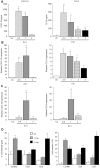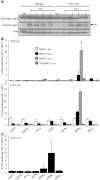Intrahepatic infiltrating NK and CD8 T cells cause liver cell death in different phases of dengue virus infection
- PMID: 23050007
- PMCID: PMC3458800
- DOI: 10.1371/journal.pone.0046292
Intrahepatic infiltrating NK and CD8 T cells cause liver cell death in different phases of dengue virus infection
Abstract
Elevated liver enzyme level is an outstanding feature in patients with dengue. However, the pathogenic mechanism of liver injury has not been clearly demonstrated. In this study, employing a mouse model we aimed to investigate the immunopathogenic mechanism of dengue liver injury. Immunocompetent C57BL/6 mice were infected intravenously with dengue virus strain 16681. Infected mice had transient viremia, detectable viral capsid gene and cleaved caspase 3 in the liver. In the mean time, NK cell and T cell infiltrations peaked at days 1 and 5, respectively. Neutralizing CXCL10 or depletion of Asialo GM1(+) cells reduced cleaved caspase 3 and TUNEL(+) cells in the liver at day 1 after infection. CD8(+) T cells infiltrated into the liver at later time point and at which time intrahepatic leukocytes (IHL) exhibited cytotoxicity against DENV-infected targets. Cleaved caspase 3 and TUNEL(+) cells were diminished in mice with TCRβ deficiency and in those depleted of CD8(+) T cells, respectively, at day 5 after infection. Moreover, intrahepatic CD8(+) T cells were like their splenic counterparts recognized DENV NS4B(99-107) peptide. Together, these results show that infiltrating NK and CD8(+) T cells cause liver cell death. While NK cells were responsible for cell death at early time point of infection, CD8(+) T cells were for later. CD8(+) T cells that recognize NS4B(99-107) constitute at least one of the major intrahepatic cytotoxic CD8(+) T cell populations.
Conflict of interest statement
Figures





Similar articles
-
Lymphocyte activation and hepatic cellular infiltration in immunocompetent mice infected by dengue virus.J Med Virol. 2004 Jul;73(3):419-31. doi: 10.1002/jmv.20108. J Med Virol. 2004. PMID: 15170638
-
The Role of Heterotypic DENV-specific CD8+T Lymphocytes in an Immunocompetent Mouse Model of Secondary Dengue Virus Infection.EBioMedicine. 2017 Jun;20:202-216. doi: 10.1016/j.ebiom.2017.04.033. Epub 2017 Apr 27. EBioMedicine. 2017. PMID: 28483582 Free PMC article.
-
Dengue Virus-Infected Dendritic Cells, but Not Monocytes, Activate Natural Killer Cells through a Contact-Dependent Mechanism Involving Adhesion Molecules.mBio. 2017 Aug 1;8(4):e00741-17. doi: 10.1128/mBio.00741-17. mBio. 2017. PMID: 28765218 Free PMC article.
-
Human T Cell Response to Dengue Virus Infection.Front Immunol. 2019 Sep 4;10:2125. doi: 10.3389/fimmu.2019.02125. eCollection 2019. Front Immunol. 2019. PMID: 31552052 Free PMC article. Review.
-
Regulation and Function of NK and T Cells During Dengue Virus Infection and Vaccination.Adv Exp Med Biol. 2018;1062:251-264. doi: 10.1007/978-981-10-8727-1_18. Adv Exp Med Biol. 2018. PMID: 29845538 Free PMC article. Review.
Cited by
-
Micronutrients, Immunological Parameters, and Dengue Virus Infection in Coastal Ecuador: A Nested Case-Control Study in an Infectious Disease Surveillance Program.J Infect Dis. 2020 Jan 1;221(1):91-101. doi: 10.1093/infdis/jiz427. J Infect Dis. 2020. PMID: 31428794 Free PMC article.
-
Tissue-Resident NK Cells Mediate Ischemic Kidney Injury and Are Not Depleted by Anti-Asialo-GM1 Antibody.J Immunol. 2015 Nov 15;195(10):4973-85. doi: 10.4049/jimmunol.1500651. Epub 2015 Oct 9. J Immunol. 2015. PMID: 26453755 Free PMC article.
-
Experimental Yellow Fever in Squirrel Monkey: Characterization of Liver In Situ Immune Response.Viruses. 2023 Feb 16;15(2):551. doi: 10.3390/v15020551. Viruses. 2023. PMID: 36851765 Free PMC article.
-
Addition of Partial Envelope Domain II into Envelope Domain III of Dengue Virus Antigen Potentiates the Induction of Virus-Neutralizing Antibodies and Induces Protective Immunity.Vaccines (Basel). 2020 Feb 15;8(1):88. doi: 10.3390/vaccines8010088. Vaccines (Basel). 2020. PMID: 32075300 Free PMC article.
-
Liver transcriptomics reveals features of the host response in a mouse model of dengue virus infection.Front Immunol. 2022 Aug 26;13:892469. doi: 10.3389/fimmu.2022.892469. eCollection 2022. Front Immunol. 2022. PMID: 36091000 Free PMC article.
References
-
- Kuo CH, Tai DI, Chang-Chien CS, Lan CK, Chiou SS, et al. (1992) Liver biochemical tests and dengue fever. Am J Trop Med Hyg 47: 265–270. - PubMed
-
- Huerre MR, Lan NT, Marianneau P, Hue NB, Khun H, et al. (2001) Liver histopathology and biological correlates in five cases of fatal dengue fever in Vietnamese children. Virchows Arch 438: 107–115. - PubMed
-
- Kalayanarooj S, Vaughn DW, Nimmannitya S, Green S, Suntayakorn S, et al. (1997) Early clinical and laboratory indicators of acute dengue illness. J Infect Dis 176: 313–321. - PubMed
-
- Souza LJ, Alves JG, Nogueira RM, Gicovate Neto C, Bastos DA, et al. (2004) Aminotransferase changes and acute hepatitis in patients with dengue fever: analysis of 1,585 cases. Braz J Infect Dis 8: 156–163. - PubMed
Publication types
MeSH terms
LinkOut - more resources
Full Text Sources
Medical
Molecular Biology Databases
Research Materials

